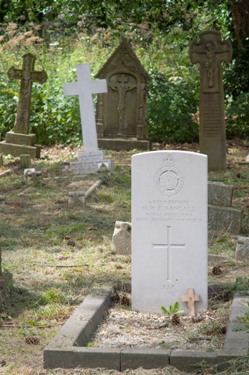 Geologist and science writer Nina Morgan commemorates the stone that marks remembrance
Geologist and science writer Nina Morgan commemorates the stone that marks remembrance
In the year that marks a century since the outbreak of the First World War many are moved by the peaceful and dignified settings of the war cemeteries. These were the brainchild of Sir Fabian Ware (1869-1949), the driving force behind the establishment of the Imperial War Graves Commission in 1917, now known as the Commonwealth War Graves Commission.
Picture: Churchyards often contain war graves of the standard design, as well as private war graves chosen by relatives and put up at their own expense. In the churchyard if Saints Mary and John, Cowley Road Oxford, a private war grave in the form of a white cross in Carrara marble (in the background), stands near a standard Portland war grave headstone.
Advisers
Ware's idea quickly caught on. Although in the popular imagination the architect most closely associated with the design of war graves is Sir Edwin Lutyens (1869-1944), creator of the Cenotaph in London, in fact, a host of other artistic advisers – including two other architects, Sir Herbert Baker and Sir Reginald Blomfield – also played key roles. As a result, ideas for the design of the cemeteries flowed in thick and fast. The palaeographer and biblical and classical scholar, Sir Frederic Kenyon (1863-1952), director of the British Museum, was drafted in early on to head a Commission to coordinate the various artistic ideas.
The Commission's report, published in February 1918, suggested that the bigger cemeteries should also include large memorials. Two designs were chosen: Blomfield's Cross of Sacrifice, for use in cemeteries containing over 40 graves; and Lutyens' iconic Stone of Remembrance – consisting of a 12 foot-long block of Upper Jurassic Portland Base Bed, inscribed with the text ‘Their name liveth for evermore’ and lying on three steps - for cemeteries with over 1000 graves.
Headstones
But when it came to headstones, the design and choice of materials was determined by a committee working for the Commission. ‘Equality’ was the guiding principle behind the design; a stone that was easy to care for and which could hold a carved inscription well was the key requirement. In short, stone from the Portland Base Bed – readily available, affordable and durable – fitted the bill. And because it is composed largely of small, dense ooliths that continually wear off to expose new ones beneath, it tends to retain its pale colour as it weathers, so is easy to maintain. During the Second World War, the Commission considered using granite for headstones in Scotland, but thwarted by a ring operated by quarry owners, it found granite too expensive – so again, Portland won the day.
And thus, the dignified narrow white Portland headstones with slightly curved tops, bearing only a national emblem or regimental badge, and the rank, name, unit, date of death and age of each casualty inscribed above an appropriate religious symbol and a more personal dedication chosen by relatives, came to be the standard.
The war cemeteries, with their serried ranks of gleaming white Portland headstones, along with the distinctive individual white Portland headstones of the war-dead found scattered among gravestones of different stones and designs in cemeteries and churchyards throughout the UK, bear testimony to the fact that sometimes, a committee really CAN get things right!
Acknowledgement
The many events marking the centenary of the outbreak of the First World War provided the inspiration for this vignette. Sources included e-mail correspondence with Barry Hunt, Director, IBIS Limited, and his article about
Portland Limestone in
Natural Stone Specialist, May 2014, pp. 34-38;
The Unending Vigil: The history of the Commonwealth War Graves Commission, by Philip Longworth, ISBN 978184884423; the Commonwealth War Graves Commission website
www.cwcg.org ; the Commonwealth War Graves Commission media centre; the article Anstrude and Portland.
Similar or not, by Tim Palmer,
Natural Stone Specialist, March 2001, pp. 31-32; and work I am carrying out with Philip Powell of the University Museum of Natural History in Oxford for a book about the Geology of Gravestones.
- If the past is the key to your present interests, why not join the History of Geology Group (HOGG). For more information and to read the latest HOGG Newsletter, visit the HOGG website at: www.historyofgeologygroup.co.uk, where you'll also find abstracts for the talks and posters presented at the Conference on Geological Collectors and Collecting, April 2011 available free to download as a pdf file.
* Nina Morgan is a geologist and science writer based near Oxford. She is currently working on a book about the Geology of Gravestones.